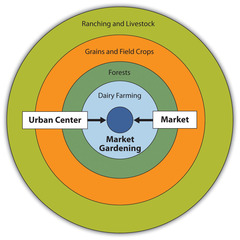AP Human Geography "Agriculture" Chapter 10 – Flashcards
Unlock all answers in this set
Unlock answersquestion
Long lot survey
answer
System implemented in Quebec, Louisiana, Texas or areas of French influence, that divide the land into narrow parcels stretching back from rivers, roads, or canals
question
Rain forest agriculture
answer
Also known as slash-and-burn agriculture. This is a subsistence design and is the better way to utilize farming in the rainforest. Shifting Agriculture (Slash & Burn).
question
Vegetative planting
answer
The earliest form of plant cultivation, according to Carl Sauer, was vegetative planting, (direct cloning from existing plants, such as cutting stems and dividing roots) Originated in South East Asia The first plants domesticated in Southeast Asia.. . probably included roots such as the taro and yam, and tree crops such as the banana and palm. Southeast Asia West Africa Northwest south America
question
Primary sector
answer
The portion of the economy concerned with the direct EXTRACTION OF MATERIALS FROM EARTHS SURFACE, generally through AGRICULTURE, although sometimes by mining, fishing, and forestry (extraction of natural resources from an environment)
question
Subsistence agriculture
answer
The production of food primarily for consumption for the farmer's family. 65-70% of farmers in the labor force. Farmers do much of the work with hand tools and animal power. Farm size is small. No relationship of farming to other businesses.
question
Dairy farming regions
answer
California, Wisconsin, New York, Pennsylvania
question
Leading exporter of the US
answer
Machines, engines, pumps: US$219,566,232,000 (13.5% of total exports).
question
Agricultural hearths
answer
South W. Asia -Barley -Wheat -Lentils -Olives East Asia -Rice and Millet Sub Saharan Africa -Sorghum -Yams -Millet -Rice Latin America/ Meso America -Beans -Cotton -Potatoes -Maize (MOST IMPORTANT)
question
Leading producers of wheat
answer
United States: Winter Wheat Belt: Kansas, Colorado, and Oklahoma, Spring Wheat Belt: the Dakotas, Montana, and southern Saskatchewan in Canada, Parlous Region: Washington State. And also Canada, Argentina, Australia, France, and the United Kingdom.
question
SE U.S agriculture
answer
Peanuts, tobacco, rice, and cotton deal with integrated farming is not based on a set of fixed parameters but on informed management processes.
question
Criticism over green revolution
answer
Some criticize that the Green Revolution has unsafe procedures that can lead to harms in the people whom consume the crops as well as in the environment around them.
question
Extensive subsistence
answer
Land far from markets in rings three and four. Grain farmers and ranchers settled on larger, less expensive land farther away from urban areas.
question
Columbian exchange
answer
The trading of food stuffs between the Western and Eastern Hemispheres across the Pacific and Atlantic oceans beginning in the 15th and 16th centuries with the trans-ocean trade routes (rice from Asian, potatoes to North America, etc). Late 15th and 16th centuries, products carried both ways across Atlantic and Pacific Oceans.
question
US agriculture labor force
answer
2% farmers, 20% food production related to agribusiness.
question
Most produced greens
answer
Wheat, barley, millet, maize, rice, sorghum, tiff, soybean, and quinoa.
question
Slash and burn
answer
Existing vegetation is cut down and burned off before new seeds are sown, typically used as a method for clearing forest land for farming related to shifting cultivation.
question
Cornbelt
answer
It extends from Ohio to the Dakotas, with its center in Iowa. The corn and soybeans are making rapid inroads among farms there.
question
Transhumance
answer
Seasonal migration of livestock between mountains and lowland pasture areas.
question
Organic agriculture
answer
farming and ranching that avoids the use of herbicides, pesticides, growth hormones, and other similar synthetic inputs.
question
Plantation crops
answer
Among the most important crops are cotton, sugarcane, coffee, rubber, and tobacco, cocoa, jute, bananas, tea, coconuts, and palm oil.
question
Agricultural revolution 1
answer
-Dating back 10,000 years -the First Agricultural revolution achieved plant domestication and animal domestication -Beginning of civilization -Neolithic Period 10,000 - 15,000 years ago
question
Agricultural revolution 2
answer
-Dovetailing with and benefiting from the Industrial Revolution -The Second Agricultural Revolution witnessed improved methods of cultivation, harvesting, and storage of farm produce
question
Agricultural revolution 3
answer
-Currently in progress -The Third Agricultural Revolution has as its principal orientation the development of Genetically Modified Organisms (GMOs).
question
Von Thünen's model

answer
A model that explains the location of agricultural activities In a commercial, profit- making economy ( closest to the center = more perishable and decreases as circle expands) O - Central City Each town was a market surrounded by a set of concentric (having a common center) rings that featured different crops. 1- Market gardening and dairying Food that will decay rapidly is closest to the central city because it decays rapidly and is expensive to deliver. EX: Milk, tomatoes, strawberries, fruits/veggies 2-Forest Cars, oxen, and other animals, carry logs to the center; the tress are heavy so they must be semi close to the central city. 3-Field crops/Grains (extensive) These crops are less likely to spoil so they don't need to be as close to the central city. These crops rotate yearly and EX: wheat, barley, oats 4-Ranching/ Livestock (animal grazing) livestock require a lot of area to graze and this outermost ring is dedicated to this. Animals must travel to central city by foot and then get slaughtered in the central city After this it becomes to expensive, it generally becomes unprofitable to farm commercially because the transportation costs become too high. [Wilderness]
question
Commercial agriculture
answer
The production of food primarily for sale off the farm. 5% of farmers in the work force. Farmers rely on machinery to perform work, rather than relying on people or animals. Farm size is large, average is about 449 acres in the U.S. closely tied to other businesses.
question
Swidden agriculture
answer
A swidden is a patch of land cleared for planting through slashing and burning. Swiddens are used for about 3 years or less, farmers will return in 6 years or as much as 20 years.
question
Horticulture
answer
The growing of fruits, vegetables, and flowers—and tree crops form the commercial base of the Mediterranean farming.
question
Sahel
answer
The arid area on the S flank of the Sahara desert that stretches across six countries from Senegal to Chad. The countries are Senegal, Chad, Niger, Nigeria, Sudan, and Mauritania.
question
Agribusiness
answer
Commercial agriculture characterized by integration of different steps in the food-processing industry, usually through ownership by large corporations.
question
Mediterranean agriculture
answer
-Others: California, central Chile, the southwestern part of South Africa, and southwestern Australia -Prevailing sea winds provide moisture and moderate the winter temperatures. -Summers are hot and dry. -The land is very hilly. - Exists primarily in the lands that border the Mediterranean Sea - Most crops are grown for HUMAN consumption rather than for animal feed - 2 most important cash crops are OLIVES ; GRAPES - Despite the importance of olives ; grapes, approximately half of the land is devoted to growing CEREALS, especially WHEAT for pasta ; bread
question
Why rotate crops?
answer
The practice of rotating use of different fields from crop to crop each year, to avoid exhausting the soil.
question
Wattle
answer
The framework consisting of stakes interwoven with branches to form a fence. Or houses built from poles and sticks women and plastered with mud. Found in Africa.
question
Intensive subsistence regions
answer
Rings 1 ; 2. Closest to the market center. Dairy and truck farmers sought smaller plots of relatively expensive land close to cities. ? Must be intensively worked to produce to attain food from the land to survive on, in primarily Southwest Asia, in wet climate - rice, in dry climates - other crops.
question
Agriculture
answer
The deliberate effort to modify a portion of Earth's surface through the cultivation of crops and raising life stock for sustenance or economical gain
question
Carl Sauer
answer
Geographer from the U of Cali at Berkley who defined the concept of cultural landscape as the fundamental unit of geographical analysis. Came up with the ideas of cultivations beginnings and has had a heavy hand in human geographical agricultural theory.
question
GMO's
answer
Genetically Modified Organisms -A field of biotechnology that sprung in the 3rd AGRICULTURAL REVOLUTION -Dealing with hybrids/ cross breading of plants ; animals -75% of all processed food in America are genetically modified (according to grocery manufactures) EX: CORN, SOYBEANS, plums, canola, Umbuku Lizard, the Paper Tree, the Fern Spider (Part Plant, Part Animal),
question
Seed agriculture
answer
Western India Northern China Ethiopia: Millet + Sorghum Southeast Asia: Probably rice South Mexico: squash + Maize North Peru: Beans, cotton, squash
question
seed agriculture diffusion
answer
Many domesticated plants and animals were brought from Southwest Asia. From the northern China hearth, millet diffused go South Asia and Southeast Asia. Sauer identified a third independent hearth in Ethiopia, where millet and sorghum were domesticated early. Production of plants through annual planting of seed, came later, most farmers today practice this.
question
Agriculture in LDC's
answer
-Pastoral nomadism is a form of subsistence agriculture based on the herding of domesticated animals. -More commonly, women and children of a nomadic group tend to crops at a fixed location. -Nomads may hire worker to practice sedentary agriculture. -Some nomads will remain in a place and cultivate the land only when rainfall is abundant.
question
IR8
answer
Also rice, before IR36 but weaker
question
IR36
answer
By 1992 the most widely grown crop was called IR 36 (A variety of rice) -Most common grain of rice used today -Produces bigger head, strong stem, better yield of rice than any other rice (researched hybrid from Mex. then to India) -bred from 13 parents to obtain resistance to 15 pest, growth cycle of 110 days - invented during the third agricultural revolution a.k.a green revolution -assures at least 3 harvests of rice per year



